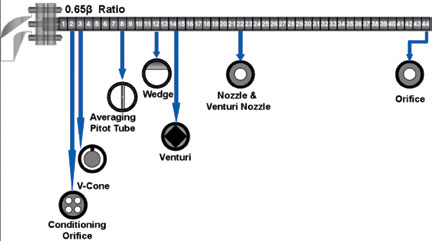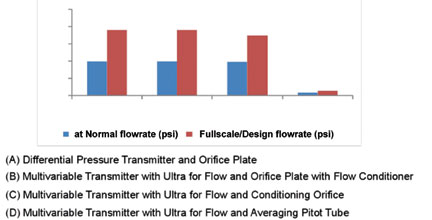DP Flow Meter Selection(III)
Date:2016-1-27
Permanent Pressure Loss (PPL)
Whenever a piece of equipment is added to a flow system, pressure is lost. This pressure loss makes the pump or compressor work harder to generate the same flows in the system. In the case of flow meters, a loss is incurred because a piece of straight pipe would not have as much loss as the flow meter. This pressure loss varies by DP flow meter. Starting with the orifice plates (highest PPL) and sorted in descending order of permanent pressure loss are orifice/nozzle, wedge, V-cone, venturi and Averaging Pitot Tube.
A properly sized orifice plate with a beta ratio of 0.6 will typically lose 40 percent of the sensed DP to permanent pressure loss, whereas an Averaging Pitot Tube has a blockage range between 15 and 20 percent. Lowering permanent pressure loss will reduce pumping or compressing costs, increase capacity and minimize the size requirements for the compressor, pump or boiler. For this article's example, the permanent pressure loss for each flow meter is shown in Figure 4.
Straight Pipe Run Requirements
Traditional orifice plate flow meters require long straight pipe lengths to meet specifications. Minimizing piping requirements improve performance and lower installed cost. This presents a challenge as most plants are not designed with sufficient straight pipe, making it difficult to engineer and add flow measurements. Technologies are available that require shorter straight run, thus eliminating the need for costly piping modifications. Figure 5 plots the piping requirements of the various options available in the market.

Using technology designed for short straight run can enhance performance. In a 2 in. line size with a 0.4β and 2D straight run with an induced swirl, selecting a conditioning orifice plate, which only requires two pipe diameters upstream and two pipe diameters downstream, improves the flow measurement accuracy to 0.5 percent compared to a standard orifice.
Another benefit is that these technologies allow mounting at grade, allowing for easier access and increased operator safety. The lower installed costs are realized from the savings in labor, procurement, design and engineering, and materials.
Environmental and Safety Needs
Minimizing leak potential is critical in mitigating negative emissions and hazardous waste effects. Traditional installations require impulse lines. The impulse lines create numerous potential leak points, and have a tendency to plug, leading to inconsistencies in measurement. The potential for leak points is significantly reduced in a best practice installation, where the pressure transmitter is directly mounted to the primary element, thus eliminating the need for impulse lines and ultimately improving the measurement's reliability. This equates to cost and time savings—less process fluid lost, energy wasted and maintenance necessary in repairing leaks—and improves overall personnel safety. A three year user study found that replacing impulse line with direct mount technologies resulted in a 90 percent reduction in work orders, and 46 percent reduction in total maintenance cost.
Economic Factors
In a traditional installation, the materials costs, namely the price of the components, accounts for only 65 percent of the total installed costs. The remaining 35 percent is comprised of engineering (sizing technology and creating specification sheets and drawings), procurement (generating purchase order and managing delivery dates) and labor costs (preparing piping, installing and commissioning). Selecting the right DP flow meter can generate substantial savings in the total installed cost. For instance, choosing a directly mounted flow meter over a traditional orifice meter can translate to a total installed cost savings ranging from 20 to 30 percent, depending on the line size.
In general, no perfect flow meter meets every application need. Every application should be considered individually. Start with the end in mind by considering the purpose of the measurement. Make sure the application requirements are understood and met. Eliminate any technology that cannot handle the application. Finally, prioritize, rank and optimize flow meter capabilities to guarantee a customized recipe for success.
Whenever a piece of equipment is added to a flow system, pressure is lost. This pressure loss makes the pump or compressor work harder to generate the same flows in the system. In the case of flow meters, a loss is incurred because a piece of straight pipe would not have as much loss as the flow meter. This pressure loss varies by DP flow meter. Starting with the orifice plates (highest PPL) and sorted in descending order of permanent pressure loss are orifice/nozzle, wedge, V-cone, venturi and Averaging Pitot Tube.
A properly sized orifice plate with a beta ratio of 0.6 will typically lose 40 percent of the sensed DP to permanent pressure loss, whereas an Averaging Pitot Tube has a blockage range between 15 and 20 percent. Lowering permanent pressure loss will reduce pumping or compressing costs, increase capacity and minimize the size requirements for the compressor, pump or boiler. For this article's example, the permanent pressure loss for each flow meter is shown in Figure 4.

Figure 4. Permanent pressure loss for DP flowmeters
Straight Pipe Run Requirements
Traditional orifice plate flow meters require long straight pipe lengths to meet specifications. Minimizing piping requirements improve performance and lower installed cost. This presents a challenge as most plants are not designed with sufficient straight pipe, making it difficult to engineer and add flow measurements. Technologies are available that require shorter straight run, thus eliminating the need for costly piping modifications. Figure 5 plots the piping requirements of the various options available in the market.

Figure 5. Upstream straight run piping requirements by technology
Using technology designed for short straight run can enhance performance. In a 2 in. line size with a 0.4β and 2D straight run with an induced swirl, selecting a conditioning orifice plate, which only requires two pipe diameters upstream and two pipe diameters downstream, improves the flow measurement accuracy to 0.5 percent compared to a standard orifice.
Another benefit is that these technologies allow mounting at grade, allowing for easier access and increased operator safety. The lower installed costs are realized from the savings in labor, procurement, design and engineering, and materials.
Environmental and Safety Needs
Minimizing leak potential is critical in mitigating negative emissions and hazardous waste effects. Traditional installations require impulse lines. The impulse lines create numerous potential leak points, and have a tendency to plug, leading to inconsistencies in measurement. The potential for leak points is significantly reduced in a best practice installation, where the pressure transmitter is directly mounted to the primary element, thus eliminating the need for impulse lines and ultimately improving the measurement's reliability. This equates to cost and time savings—less process fluid lost, energy wasted and maintenance necessary in repairing leaks—and improves overall personnel safety. A three year user study found that replacing impulse line with direct mount technologies resulted in a 90 percent reduction in work orders, and 46 percent reduction in total maintenance cost.
Economic Factors
In a traditional installation, the materials costs, namely the price of the components, accounts for only 65 percent of the total installed costs. The remaining 35 percent is comprised of engineering (sizing technology and creating specification sheets and drawings), procurement (generating purchase order and managing delivery dates) and labor costs (preparing piping, installing and commissioning). Selecting the right DP flow meter can generate substantial savings in the total installed cost. For instance, choosing a directly mounted flow meter over a traditional orifice meter can translate to a total installed cost savings ranging from 20 to 30 percent, depending on the line size.
In general, no perfect flow meter meets every application need. Every application should be considered individually. Start with the end in mind by considering the purpose of the measurement. Make sure the application requirements are understood and met. Eliminate any technology that cannot handle the application. Finally, prioritize, rank and optimize flow meter capabilities to guarantee a customized recipe for success.
- Pre:How Does Temperature Transmitter Works ? 2016/1/28
- Next:India Exhibition-2013 2013/8/9
